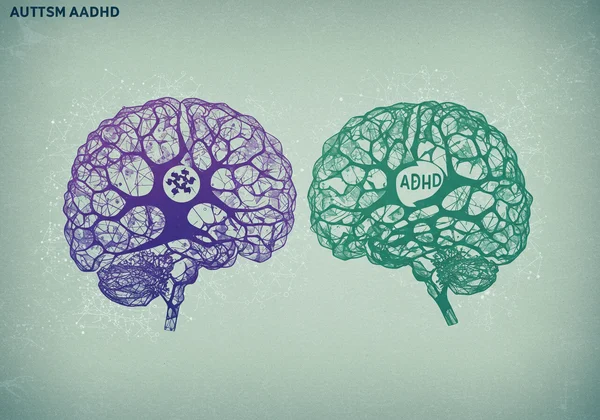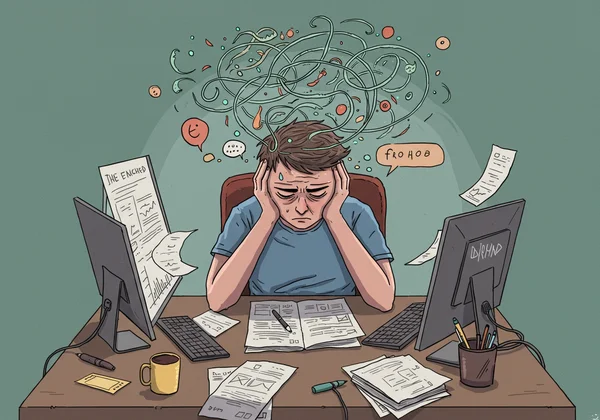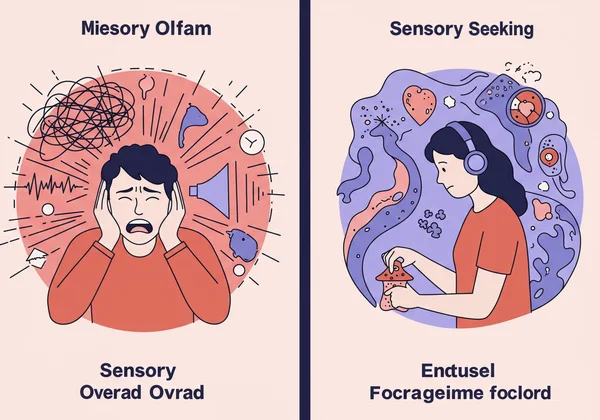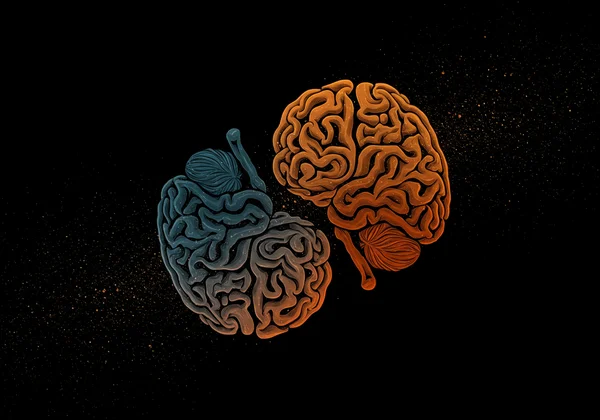我是自闭症还是多动症?了解特质并进行自闭症测试
感觉自己被重叠特质的旋涡所困,可能会让人感到困惑。您可能会注意到高度专注、社交挑战或感官敏感性,并想知道:“我是自闭症还是多动症?” 这是一个常见的问题,在寻求答案的路上您并不孤单。本指南旨在帮助您了解自闭症谱系障碍 (ASD) 和注意缺陷多动障碍 (ADHD) 之间的显著相似点和关键区别,赋能您的自我认知之旅。如果您正在寻找一个起点,一份保密的 自闭症筛查工具 可以提供宝贵的初步见解。我怎么知道自己是不是自闭症? 这通常始于了解您独特的个人情况,我们在此帮助您 开启您的旅程。

免责声明:本文仅供参考。我们网站上的筛查工具旨在用于初步自我评估,不能替代专业的医学诊断。如有任何健康问题,请咨询合格的医疗保健专业人员。
解读重叠:为什么自闭症和多动症看似相似
许多人质疑自闭症和多动症之间差异的原因,在于它们在表现方式上存在显著的 自闭症与多动症的重叠之处。两者都是神经发育状况,意味着它们会影响大脑的生长和功能。这种神经发育上的共同根源导致了一些相似的可观察行为,即使其潜在原因不同。理解这种重叠是迈向清晰的第一步。
执行功能和注意力方面的共同挑战
最显著的重叠领域之一在于 执行功能障碍。这个术语指的是在工作记忆、灵活思维和自我控制等一系列心智技能方面的困难。对于自闭症人士和多动症患者来说,这可能表现为组织任务、管理时间、启动项目和保持专注方面的挑战。

患有多动症的人可能难以集中注意力,因为他们的大脑不断寻求新的刺激,从而导致分心。自闭症人士可能因为难以从一项活动过渡到另一项活动,或被感官环境所压倒而在执行同一任务时面临挑战。结果——一个未完成的项目——看起来是相同的,但内部体验截然不同。
社交困难:根源不同,结果相似
应对社交场合也可能是一个共同的挑战。旁观者可能会观察到患有这两种状况的人存在社交笨拙、难以维持友谊或误解对话规范。然而,其根本原因往往不同。社交信号 可能是一个主要因素。
对于自闭症人士来说,社交困难可能源于处理社交信息的不同方式。这可能包括按字面意思理解语言,无法本能地捕捉非语言线索(如肢体语言或语调),或社交互惠(如对话的流畅互动)方面的挑战。对于多动症患者来说,社交挑战可能源于冲动性,例如打断他人、言语过多或在他人讲话时显得心不在焉。结果是相似的,但驱动因素是不同的大脑神经连接。
主要区别:区分成人自闭症与多动症的特质
尽管重叠之处甚多,但仍存在核心差异可以帮助区分两者。更仔细地审视 成人多动症与自闭症的症状 会揭示沟通、感官处理和兴趣方面的独特模式。认识这些细微差别是理解您个人经历的关键,并可能帮助您更好地解读 在线自闭症测试 的结果。
沟通风格:互惠性 vs. 冲动性
核心的 沟通模式 通常存在分歧。自闭症人士的沟通特点通常是偏爱直接、诚实和逻辑性信息。他们可能专注于特定兴趣话题,较少强调“闲聊”。社交互惠的挑战并非缺乏连接的渴望,而是大脑处理对话互动的方式不同。
相比之下,多动症相关的沟通挑战通常源于冲动和注意力不集中。这可能表现为频繁更换话题、替他人说完句子,或难以长时间倾听。连接的渴望很强烈,但大脑的调节系统会使流畅、互惠的对话变得困难。
感官处理:超载 vs. 刺激不足
我们通过感官体验世界的方式是一个主要的差异所在。许多自闭症人士会经历 感官超载,常见的视觉、听觉、嗅觉或触觉会让他们感到强烈地难以承受甚至痛苦。这种高敏感性可能导致旨在减少感官输入的行为,例如戴耳机或避免拥挤场所。相反,一些人可能会经历低敏感性,寻求强烈的感官输入。

多动症患者更可能经历感官刺激不足,并从事 感官寻求 行为以保持大脑的活跃和专注。他们的大脑渴望刺激。这就是为什么坐立不安、工作时听音乐或持续的动作(在不同语境下的刻板行为)实际上可以帮助多动症患者集中注意力。这不是被输入压倒,而是产生足够的输入以保持大脑的参与度。
特殊兴趣 vs. 超聚焦:激情的细微差别
自闭症人士和多动症患者都可能对他们热衷的活动表现出高度专注。然而,这种专注的性质有所不同。自闭症的 特殊兴趣 通常是对特定主题深刻、持久的热情。它是他们身份不可或缺的一部分,是深刻的快乐和专业知识的来源,也是理解和与世界互动的方式。
多动症与 超聚焦 相关,这是一种对新奇、有趣或刺激事物的高度集中、短期状态。在超聚焦状态下,多动症患者会完全忘记时间和周围环境。然而,这些强烈兴趣的时期可能比自闭症的特殊兴趣更频繁地转移,并且通常与新奇和即时奖励相关。
理解共现:关于“AuDHD”特质的现实
更复杂的是,个体同时患有自闭症和多动症是很常见的。这种共现通常被称为 AuDHD 特质。拥有这种双重神经类型意味着要应对一种独特的特质组合,这些特质有时会相互矛盾或相互掩盖。例如,自闭症对规律和可预测性的需求可能与多动症对新奇和自发性的追求发生冲突。
双重神经类型对您意味着什么?

拥有 AuDHD 意味着您的体验是独一无二的。您有时可能会觉得自己是一个活生生的矛盾体——渴望社交互动却又很快被其压倒,或者精心规划一个项目却在半途分心。理解这种组合对于制定有效的应对策略和培养自我同情心至关重要。初步筛查,例如 免费自闭症谱系测试,可以成为理清这些复杂线索的有用工具。
您的下一步:从自我反思到更清晰的理解
这些信息是反思的起点,并非诊断工具。其目标是为您提供语言和框架,以更好地理解您自己的经历。从这里开始,您可以采取明智、积极的步骤,以获得更大的清晰度和自我接纳。
何时考虑在线自闭症测试以获取初步见解
如果您在自闭症特质的描述中看到了自己,那么下一步就是通过保密的在线筛查工具 探索您的特质。像我们网站上提供的 在线自闭症测试,是基于成熟的问卷,如自闭症谱系商数 (AQ) 测试。它提供了一种私密、无压力的自我数据收集方式,并查看您的特质如何与自闭症的典型特征相符。测试结束后,您可以选择接收一个简单的分数,或解锁一个更详细的、由人工智能驱动的报告,提供关于您的优势和挑战的个性化见解。
专业评估对于诊断的重要性
必须强调的是:在线测试仅用于筛查和自我探索,而非诊断。正式的 专业诊断评估 必须由合格的医疗保健专业人员进行,例如心理学家或精神科医生。他们将进行全面的评估,其中可能包括访谈、临床观察和标准化评估工具。这个过程对于任何寻求官方便利、治疗支持或明确医学结论的人来说都至关重要。将在线筛查工具的见解作为一种工具,帮助您决定是否值得寻求专业评估。
您的前行之路:拥抱自我理解
理清自闭症和多动症的线索是一个个人化且通常复杂的过程。认识到沟通、感官体验和兴趣方面的关键差异——以及显著的重叠——是赋能的一步。您是自己生活的主人,收集信息是倡导自身福祉的最佳方式。
您的自我理解之旅是有效且重要的。如果这篇文章引起了您的共鸣,我们邀请您迈出下一步。请参加我们免费、保密的 成人自闭症测试。这可能是您更深入地了解自己并拥有更充实生活的第一步。
关于自闭症与多动症重叠的常见问题
我是自闭症还是仅仅社交笨拙?
社交笨拙可能是多种不同经历的一部分,包括社交焦虑、自闭症,甚至仅仅是内向。关键区别通常在于其根本原因。对于自闭症人士来说,这可能源于处理社交信号的不同方式。在线筛查工具可以帮助您查看是否拥有其他常见的自闭症特质,从而提供更多背景信息。
你会带有轻微自闭症特质吗?
自闭症是一个谱系,这意味着它对每个人的影响不同,程度也各异。虽然“轻微自闭症”并非临床术语,但它反映了某些人自闭症特质对其日常生活影响相对较小的现实。谱系的概念意味着存在广泛的体验。
我怎么知道自己是否患有自闭症?
自我发现是一个过程,通常始于感觉自己与众不同,然后是研究。阅读此类文章、了解其他自闭症人士的经历,以及进行一项备受认可的筛查工具测试,都是有价值的步骤。自闭症筛查测试 可以提供关于您特质的结构化见解,这可以指导您决定是否寻求专业评估以获得确切的诊断。
在线自闭症筛查工具准确吗?
像我们这样的在线测试是作为筛查工具设计的,而非诊断工具。它们基于经过科学验证的问卷,可以准确表明自闭症特质的存在。可以将其视为一个可靠的第一步,它能为您提供与医疗保健专业人员进行更富有成效的交流所需的信心和信息。